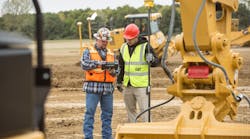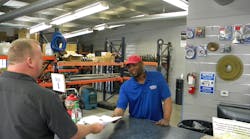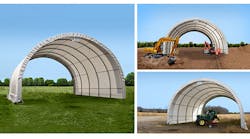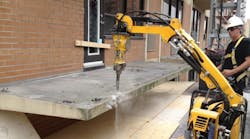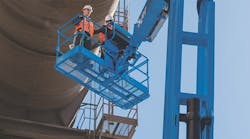Most people in the rental industry expected 2020 to be another good year, continuing a long stretch of growth years going back to the recovery from the Great Recession of 2007-2009. But, as it turned out, the number 20 was not the dominant number in a year most would like to forget. The number was 19 – as in COVID-19 – and it changed the world, causing the deaths, as of this writing, of 281,000 in the United States and 1.53 million people worldwide.
In the rental industry, COVID-19 changed the way everyone does business. For the most part, nobody can enter a rental business without a mask or facial covering, and drivers and sales staff can’t go on a jobsite without a mask either, if they can go onsite at all. Rental customers and other visitors generally must observe social distancing and counter staff in many rental centers sit behind plexiglass protectors. Equipment is meticulously cleansed before being delivered or brought out to a customer, and most jobsites are equally careful in keeping equipment clean and protecting operators. At least we hope that’s the case.
And we don’t know how long this will go on. While, as of this writing, vaccines are on the horizon, we still aren’t sure how effective they’ll be, how available they’ll be, and when life will really go back to “normal.” Even that, most likely, will be a “new normal.”
With many jobs postponed or cancelled, needless to say, it’s no surprise that the American Rental Association is forecasting a 13-percent decline in equipment and event rental revenue this year compared to 2019, dropping to $48.7 billion in the United States, with a slight 0.3-percent uptick projected for 2021.
RER spoke with a few dozen rental executives for this article and found many similarities, although the range of responses was surprisingly wide, both in 2020 results and expectations for 2021.
The aerial rental segment has been particularly hard hit.
“The pandemic has truly affected our company and other equipment rental companies and distributors,” says Larry Workman, owner of Illini Hi-Reach, Crown Point, Ind., which focuses in northern Indiana and the Chicagoland area. “Estimating that rental revenues are down in the 25 to 35 percent range starting back in March 2020. Layoffs and reduced work force/work weeks are common in our area and are still in place at most companies I am familiar with.”
Lance Renzulli at High Reach Co. in Florida adds that “rental and sales fell 15 to 20 percent.” Bob Kendall, of Star Rentals in Seattle, says his company also dropped in revenue although not as severely.
“Our fiscal year-end numbers for 2020 are rental revenues down 7.5 percent and total revenue down 7 percent,” Kendall says. “The governor of Washington shut down all construction in late March for five to six weeks, which took a pretty good bite out of things. Overall, our business has remained steady but at a modestly reduced rate.”
“The impact has varied by end-user segment,” says Bill Gex, president, Anderson Equipment Co. “Residential construction continues to be strong. People are moving out of urban areas like New York and Boston, which has kept contractors very busy. Our markets in New England are actually up this year. Residential work is also strong in the eastern New York and Pittsburgh markets. On the other hand, non-residential and infrastructure work is fading. The economy was very strong at the beginning of the year and contractors were very busy. However, as contracts were completed, replacement work has softened considerably. The lack of an additional stimulus package and the current wave of COVID cases has created a lot of uncertainty with our customers.”
For some, business has continued strong, such as heavy earthmoving rental company LaLonde Equipment Rentals in Signal Hill, Calif.
“2020 has been a great year for us,” says president Brian LaLonde. “I actually feel guilty because so many industries and individuals are struggling but we have been very fortunate. We did have some jobs temporarily shut down in the beginning of the pandemic like the [Los Angeles] Rams’ SoFi Stadium, but infrastructure work is classified as essential in California, so we have been busy.”
“Our overall business is up 16 percent, with our compact equipment business up 22 percent, heavy equipment up 5 percent,” says Walter Berry of Berry Companies. “[But] material handling business is down 17 percent. The housing market in the metro areas we serve is driving the business.”
“I believe the rental industry only survived as well as it did in Q2 and Q3 because of the massive government stimulus,” says Glenn Leppo of Leppo Group. “Businesses got PPP [Paycheck Protection Program]. [Many people] were working from home and couldn’t travel. These factors, together with low interest rates combined to drive a surge in new home construction, remodeling, and upgrades like pools and patios. Absent that stimulus, that one bright spot in the construction market will disappear since non-residential and multi-family housing construction are both down.”
“The Entertainment Venue business accounts for approximately 20 percent of our annual revenue. This complete industry was a casualty of the 2020 pandemic,” says Mike Madej of Altorfer Cat Rental Power. “The local events (PGA tour, NASCAR, Lollapalooza, and outdoor summer festivals) were all canceled or greatly affected this year. Although we took a large hit in our Entertainment Venue rentals, storm-related rentals more than made up for the void. Our team was able to provide temporary power for all major hurricanes that made U.S. landfall in this historic storm season.”
“Existing revenue is down 10 to 15 percent, but online sales for new customers, is up significantly,” say Scott Cannon, CEO of BigRentz, which specializes in online rentals. “There definitely has been a pendulum shift towards online rental. We’ve adapted well to being remote and, overall, our operations haven’t been impacted much.”
Communication breakdown
The rental industry has always been based on personal relationships. Rental companies don’t just rely on clever advertising to attract customers. Sending sales staff out to jobsites on a daily basis, forging personal relationships with customers, has been the essence of the industry since its inception, with many owners and executives also spending the bulk of their time developing relationships with contractors and builders.
These person-to-person contacts have been strongly challenged in 2020, and likely will continue to be for the foreseeable future. On many jobsites now, visitors are allowed only by appointment, and in many cases not at all. And while these ties have in the past been strengthened and project deals discussed in person or over lunch, now talks over meals are less likely as restaurants and bars in most areas are only open for takeout.
“Maintaining existing relationships isn’t too hard,” says Gex. “Developing new accounts is more challenging as customers are somewhat hesitant to meet with someone they don’t know.”
“All of the tools that were considered ‘social media’ tools have become essential business tools,” says Frank Bardonaro, chief operating officer, Maxim Craneworks. “That being said, there is still the need for onsite meetings to lay out the projects in many locations. This has been done safely by following the local work rules.”
Illini’s Workman calls the pandemic’s effect on relationships “enormous.”
“Jobsites are closed to most sales contacts, and customer offices also pretty much the same,” he says.
“Many customers have shut down their jobsite offices/trailers and limited the ability of our sales teams and engineers to have access to sites,” says Ron Chilton, president of National Trench Safety. “This has caused us to do more video meetings, phone calls and provide lots of data via email. With that said, for larger or more complex jobs, we are seeing some creative ‘work arounds’ by the customers to allow them to get the input and advice that we deliver.”
High Reach’s Renzulli adds that “most all meetings, whether at the office or jobsite visits are scheduled in advance, no more cold calls or popping in on jobsites.”
In general, zoom meetings and other electronic forms of communication have become standard practice.
While these obstacles can be challenging, some say the shared understanding of the risks can bring them closer to their customers who are going through similar issues and challenges and have, for the most part, instituted similar safety protocols as the rental companies have.
“In some ways it has brought us closer,” says BigRentz’s Cannon. “COVID has been tough on everyone and there are so many people struggling personally it has resulted in relationships mattering even more.”
“We have had to be more flexible in how we delivered projects and find creative ways to overcome logistical challenges like closed airports and even borders,” says Dan Ibbetson, managing director, global products and technology, Aggreko.
Some opportunities still knock
While the pandemic has caused many projects to cancel and has slowed overall business, especially in non-residential construction, rental companies have, as they always do, kept their eyes open for opportunities that might not have been there before, and found some silver linings.
“The opportunities we see are around helping customers be safer and more productive with products and services that will add value even beyond the pandemic,” says Dale Asplund, executive vice president and chief operating officer, United Rentals. “As our whole industry has evolved, we’ve seen more acceptance of digital tools to both engage and manage fleet. Whether that is managing the rental process through the United Rentals mobile app or taking blended learning courses through United Academy, we believe this greater acceptance of digital tools will only continue to accelerate.”
“The pandemic has afforded many opportunities to support our customers in new ways,” says Guy Manuel of Stephenson’s Rental Services, Toronto. “This crisis has motivated some homeowners to complete projects they might have been putting off and it has changed some of the demands from our larger customers. We have been involved in new requirements to meet safety protocols through increased hand-washing stations and increased scaffolding and stair towers to accommodate social distancing. We have also supported the build of temporary structures for hospitals’ COVID response units and our team members have pulled together with community organizations on more local initiatives.
“We are proud to have helped our customers do some amazing things during this pandemic. One of our branches in the Greater Toronto Area worked with a local health center to set up a two-day outdoor Flu Shot Clinic. In addition, Stephenson’s has been called on for temporary lighting, power and heat for multiple pandemic response initiatives. One of our customers shifted their wine production lines to hand sanitizer lines supplying a local hospital with the donated product. We were happy to provide the trucking that delivered the hand sanitizer in wine bottles to Michael Garron Hospital in Toronto. We have been amazed by our customer ingenuity and proud to support their efforts with our time and equipment.
“Shipping contractor supplies and consumables to customers across Canada through an eCommerce platform, we have also had new customers reach us online. In addition to our branches having the longest open hours in the industry, our customers can order supplies from us online 24/7. We have had new customers come our way to secure additional PPE and supplies to keep their operations running. We are shipping PPE and consumables across Canada from Newfoundland and Labrador to British Columbia and as far North as the North West Territories. Our customers keep surprising us with how they reach us and their unique requests that allow us to be flexible and innovate on new offerings, including supporting a customer who needed specialized bits for an ice bridge build in the North West Territories.”
“One of the biggest opportunities we are seeing is a better understanding of the value of technology and having efficient systems and processes in place,” says Michael Frey, rental operations manager, Finning Canada. “E-signing for example, isn’t new but it’s becoming commonplace. Necessity drives innovation and so technology like remote monitoring is also becoming more widespread.
“As our equipment works across various applications, we do see the demand for rental equipment shift from time to time and during the pandemic we have definitely seen an increase in rentals for landscaping and home improvement projects.”
“The one area of increase in our business relating to COVID has been the rental of some additional traffic control equipment in some states to support the various COVID-19 testing stations,” says NTS’ Chilton. “We have been surprised at how quickly so many temporary testing stations were set up in the summer. Most were winding down when the new wave of cases started to hit the country in late September. Many of the testing sites that were scheduled to be closed have now been kept open, so this small new business segment has been a nice, but small positive.”
“Single family housing has gotten the biggest boost as people flee their little condos in the city for bigger houses in the suburbs with enough space for virtual learning and work from home without driving each other crazy,” says Leppo. “Next are home improvements like pools, patios and remodeling as people save money from their staycations.”
Maxim’s Bardonaro adds that some opportunities were opened that would not have been available if not for the pandemic. “We had several markets that were in our long-term strategic growth plan that were able to move up on the schedule due to greater availability of people and equipment in the market,” he says. “While we obviously want to see things get back to good health, both physically and economically, it has allowed Maxim to expand into St. Louis, San Antonio, Kansas City and Denver during the past six months."
Expectations – Cautious, Uncertain, Maybe Upbeat?
As the unexpectedly traumatic 2020 ends, it’s natural to be looking forward to 2021. The winter always is challenging in the rental business because of colder, wetter weather and in terms of the pandemic, cases have been surging for a couple of months, a trend that was widely anticipated. There is hope that a vaccine will be a widespread reality in the foreseeable future. Still the timetable is uncertain.
Ohio’s Leppo expects the homeowner business, small contractors, and single-family construction to remain strong in the first half of 2021 with travel restrictions still likely and low interest rates still favoring growth, although, he notes, those may flatten as people are free to move around. “I think there will be a gradual increase in non-residential private construction as business owners grow more comfortable,” he says. “Public building construction will suffer unless there are specific stimulus efforts since so many state and local governments are struggling.”
Leppo even sees hope for “a slow crawl out of the hole” for oil and gas markets. “Inventories are high, demand will slowly return as people become more mobile,” he expects.
“The non-residential, petrochemical, oil and gas, power gen and highway markets are all still active, but have seen regional pullback due to the various states having different shutdown protocols,” says Chilton. “Overall, most of our served markets are remaining steady except for the oil & gas segment. The crash of oil prices this year has been a huge negative influence on this industry. We suspect we will probably not see a rebound until the price of oil gets back above the $60 per barrel range and stays there for a couple of months.”
“We have seen a spike in homeowner renovation activity as people make the time to take on more home projects for which they need the right equipment,” says Stephenson’s Manuel. “Our branch-based sales associates have been busy educating customers on how to complete new home projects on their own, when they previously would have paid someone else to do them. Our largest customers who are building housing communities, high rise condos, hospitals and roads were and are our busiest segments. Unfortunately, we have small- and medium-sized customers who were more heavily impacted by the Commercial construction closures and have been slower to recover. Our overall business was affected from these delays and closures however, we are optimistic with returning activity levels that 2021 will see more segments regaining pre-pandemic momentum.
“The cost effectiveness, flexibility and outsourcing benefits of renting large and small equipment always makes sense especially when there is uncertainty in our markets. We believe rental penetration will continue to rise, and we are seeing record levels of new project starts and permits in our markets, so we remain very optimistic about 2021 and beyond.”
While the improvement for many in home construction and remodeling has been good for many, especially smaller and mid-size rentals, a slower stretch in larger, non-residential construction has had an impact.
“A significant amount of Birch’s customers in commercial construction, manufacturing, infrastructure and industrial were stopped or stalled for three months and many are still not operating at their full anticipated volume of 2020,” says Sarah Rothenbuhler, CEO, Birch Equipment. “A bright light has been the boom in the residential construction and home improvement sectors, but it takes a tremendous amount of compact excavator, nail gun and single boom and forklift rentals to make up for the delayed demand in Birch’s large material handling, aerial fleet packages, 80,000-pound excavator and super boom rentals.”
Most rental people don’t expect the economy to really get rolling until the back half of 2021 if not into 2022. But another bright spot has been the increase in adoption of technology.
“We expect telematics like remote monitoring will experience broader adoption as we move into 2021. This technology allows us to gain useful data and insights, to better serve our customers and to arrive more prepared when we need to visit a site,” says Finning’s Frey. “One of the biggest opportunities we are seeing is a better understanding of the value of technology and having efficient systems and processes in place.”
And another may be a long-term strengthening of a preference for rental over buying equipment on the part of the customer.
“Customers may be more likely to rent during challenging economic situations, as it means they can still do business without a large capital investment,” notes Frey. “Rental helps minimize the risk. They don’t need to worry about the machine sitting unused on a site, maintenance, or the hassle of selling it. Rental can also help customers balance the flow of work - scaling up or down when needed. This is particularly relevant to our customers right now with the level of uncertainty about the pandemic and how it will affect upcoming work and investment in industry sectors.”


